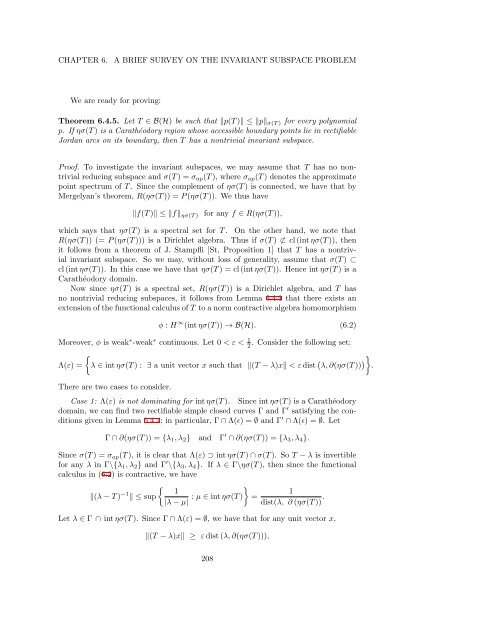Woo Young Lee Lecture Notes on Operator Theory
Woo Young Lee Lecture Notes on Operator Theory
Woo Young Lee Lecture Notes on Operator Theory
Create successful ePaper yourself
Turn your PDF publications into a flip-book with our unique Google optimized e-Paper software.
CHAPTER 6.<br />
A BRIEF SURVEY ON THE INVARIANT SUBSPACE PROBLEM<br />
We are ready for proving:<br />
Theorem 6.4.5. Let T ∈ B(H) be such that ∥p(T )∥ ≤ ∥p∥ σ(T ) for every polynomial<br />
p. If ησ(T ) is a Carathéodory regi<strong>on</strong> whose accessible boundary points lie in rectifiable<br />
Jordan arcs <strong>on</strong> its boundary, then T has a n<strong>on</strong>trivial invariant subspace.<br />
Proof. To investigate the invariant subspaces, we may assume that T has no n<strong>on</strong>trivial<br />
reducing subspace and σ(T ) = σ ap (T ), where σ ap (T ) denotes the approximate<br />
point spectrum of T . Since the complement of ησ(T ) is c<strong>on</strong>nected, we have that by<br />
Mergelyan’s theorem, R(ησ(T )) = P (ησ(T )). We thus have<br />
∥f(T )∥ ≤ ∥f∥ ησ(T ) for any f ∈ R(ησ(T )),<br />
which says that ησ(T ) is a spectral set for T . On the other hand, we note that<br />
R(ησ(T )) (= P (ησ(T ))) is a Dirichlet algebra. Thus if σ(T ) ⊄ cl (int ησ(T )), then<br />
it follows from a theorem of J. Stampfli [St, Propositi<strong>on</strong> 1] that T has a n<strong>on</strong>trivial<br />
invariant subspace. So we may, without loss of generality, assume that σ(T ) ⊂<br />
cl (int ησ(T )). In this case we have that ησ(T ) = cl (int ησ(T )). Hence int ησ(T ) is a<br />
Carathéodory domain.<br />
Now since ησ(T ) is a spectral set, R(ησ(T )) is a Dirichlet algebra, and T has<br />
no n<strong>on</strong>trivial reducing subspaces, it follows from Lemma 6.4.1 that there exists an<br />
extensi<strong>on</strong> of the functi<strong>on</strong>al calculus of T to a norm c<strong>on</strong>tractive algebra homomorphism<br />
ϕ : H ∞ (int ησ(T )) → B(H). (6.2)<br />
Moreover, ϕ is weak ∗ -weak ∗ c<strong>on</strong>tinuous. Let 0 < ε < 1 2<br />
. C<strong>on</strong>sider the following set:<br />
{<br />
Λ(ε) = λ ∈ int ησ(T ) : ∃ a unit vector x such that ∥(T − λ)x∥ < ε dist ( λ, ∂(ησ(T )) )} .<br />
There are two cases to c<strong>on</strong>sider.<br />
Case 1: Λ(ε) is not dominating for int ησ(T ). Since int ησ(T ) is a Carathéodory<br />
domain, we can find two rectifiable simple closed curves Γ and Γ ′ satisfying the c<strong>on</strong>diti<strong>on</strong>s<br />
given in Lemma 6.4.4; in particular, Γ ∩ Λ(ϵ) = ∅ and Γ ′ ∩ Λ(ϵ) = ∅. Let<br />
Γ ∩ ∂(ησ(T )) = {λ 1 , λ 2 } and Γ ′ ∩ ∂(ησ(T )) = {λ 3 , λ 4 }.<br />
Since σ(T ) = σ ap (T ), it is clear that Λ(ε) ⊃ int ησ(T ) ∩ σ(T ). So T − λ is invertible<br />
for any λ in Γ\{λ 1 , λ 2 } and Γ ′ \{λ 3 , λ 4 }. If λ ∈ Γ\ησ(T ), then since the functi<strong>on</strong>al<br />
calculus in (6.2) is c<strong>on</strong>tractive, we have<br />
{ }<br />
1<br />
∥(λ − T ) −1 ∥ ≤ sup<br />
|λ − µ| : µ ∈ int ησ(T ) 1<br />
=<br />
dist(λ, ∂ (ησ(T )) .<br />
Let λ ∈ Γ ∩ int ησ(T ). Since Γ ∩ Λ(ε) = ∅, we have that for any unit vector x,<br />
∥(T − λ)x∥ ≥ ε dist (λ, ∂(ησ(T ))),<br />
208













